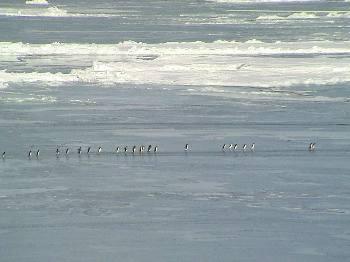15 February, 2004
Most of the time when we are collecting data we are in open water far
from the ice shelf. Today we spent most of the morning slaloming
around bergs and picking the route through the thinnest sea ice as we
did our seismic survey in the vicinity of the ice edge. Close to the
ice edge means miles rather than tens of miles, which is the norm.
At these distances, it is far more likely to see marine mammals
within sight of the ship. When the air guns for the seismic are
operating, we have a safety zone that is roughly the length of two
football fields. Seals can enter the zone lounging on an ice flow.
Pods of Orcas can simply show up from under the ice right in front of
the ship.
This morning was a busy time for whale sightings. Jerome Hall and
the bridge observed a pod of about 40 whales about a mile off the
bow. They swam in formation from port to starboard, seemingly
oblivious to the ship, as they appeared to meander along the ice edge
from flow to flow. From that time on, we knew it would be a busy
day. Twice the guns were stopped as whales entered the safety
radius. We would wait 20 minutes once they left the area before we
started firing again. The ship continues to move at 4.5 knots at
that time, so nearly 2 nautical miles of seismic data were lost, but
that is a compromise that the scientists are willing to make to share
the Antarctic seas with its marine mammals.
Sometimes they come so close to the ship, it is as if they treat us a
big orange and yellow berg. Whenever the observers see marine
mammals, people flock to the portholes and bridge to get a look. A
record of each sighting is also kept whether the animal is in the
safety radius or not. The record includes the time and location of
sighting, and the type of marine mammal observed. Observers work
one-hour shifts, and rotate every three hours when we are doing
seismic work.
Along the ice edge, freshly formed sea ice locked in the ice flows
and small bergy bits. Small colonies of penguins were scattered
about on the flows. Twice we were fortunate enough to see large
groups of penguins running single file from one small crack in the
ice to the other. They looked like they were playing follow the
leader, but the route the leader chose only seemed to confuse the
followers. They waddled along, sometimes slipping, but always
looking ahead to the penguin in front of them. Maybe that was why
they were taking such a crazy route; the leader may have been looking
for someone to follow.
Plans are being made to have all the data backed up so that the
scientists can take it with them to continue their analysis and at
some point publish the results of their efforts here for other
geologists, geophysicists and citizen scientists as well. The
Antarctic is a fascinating place. Working with the geophysics on
this cruise, I have learned an incredible amount about their science
from our discussions and just listening in to conversations and
problems solving sessions. This is a very eclectic group with a wide
range of interests. I have had the opportunity to learn about marine
biology, history, geography and literature through spontaneous
discussions prompted by events of the day. It is a twenty-four hour
classroom with each of us alternating between the role of student and
teacher throughout the day.
One of the other big projects that have been going on is the final
cataloging of rock samples from the dredges that have been conducted
during the cruise. Sam Mukasa and Jill VanTongeren have been
labeling, bagging, recording and boxing each sample for shipment back
to the University of Michigan. They will have many boxes and
hundreds of pounds of samples that will go first to New Zealand then
on to the states. Some of the rocks will be kept at a repository
here for reference by other geologists working in Antarctica in the
future. It will be interesting to find out what the chemical
analysis of these rocks by Sam, Jill and other future geologist will
tell us about the seamounts and volcanoes in the Ross Sea.

Penguins playing follow the leader.

Contact the TEA in the field at
.
If you cannot connect through your browser, copy the
TEA's e-mail address in the "To:" line of
your favorite e-mail package.
|
